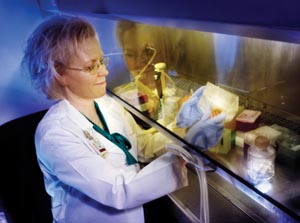In a paper published in August in the journal Breast Cancer Research and Treatment, Katri Selander, M.D., Ph.D., assistant professor in the UAB Division of Hematology and Oncology, found that the absence of Toll-like receptor 9 (TLR9), a protein that detects microbial DNA, predicts poor survival in triple negative breast cancer. The paper also offers new clues to the ways in which TLR9 influences disease progression.

Triple negative breast cancer is a subtype of breast cancer that can be particularly aggressive. It often does not respond to traditional treatments and is more likely to recur than other types of breast cancer. “Although some patients with triple negative breast cancer respond to current therapies, there is no means to predict who will do well and who won’t,” says Selander, an associate scientist in the cancer cell biology program at the UAB Comprehensive Cancer Center. “Researchers have found that not all triple negative cancers are the same. This complexity makes them more difficult to target with therapies.”
The clinical part of the study, conducted in Finland, involved tumor samples from 200 breast cancer patients that were separated into two categories — 100 samples from patients who had triple negative breast cancer and 100 from patients who had ER+ breast cancer, another subtype. Tumors from both groups were studied for TLR9 expression; patient survival also was noted. Selander and her research team found that TLR9 had prognostic significance only in those patients with triple negative cancer.
“We were able to identify TLR9 as a marker to divide triple negative breast cancer patients into those with very good prognosis and those with poor prognosis,” Selander says, based on high or low TLR9 expression levels. “We also found that in the triple negative cases where patients have low TLR9 in their tumor, the disease progresses fast and the patients relapse soon.”
In further pre-clinical studies at UAB, Selander and her team identified new clues to TLR9’s role in disease progression. By removing TLR9 expression from triple negative breast cancer cells, the researchers discovered that the combination of low oxygen concentration and low TLR9 expression makes triple negative breast cancer cells very aggressive.
The role of TLR9 in cancer pathophysiology has always been unclear. Selander and her team have been studying the protein for the past seven years, but “this is the first time we have examined the role of TLR9 in breast cancer prognosis,” she says.
This research will potentially help 10 percent of all breast cancer patients — those with triple negative breast cancer who do not respond to current treatments. “Our significant findings open a new path for drug development,” says Selander — for instance, by targeting compounds that increase TLR9 expression. “We now know where to look for the cure, and we can now ask, ‘Why do these patients do poorly?’”